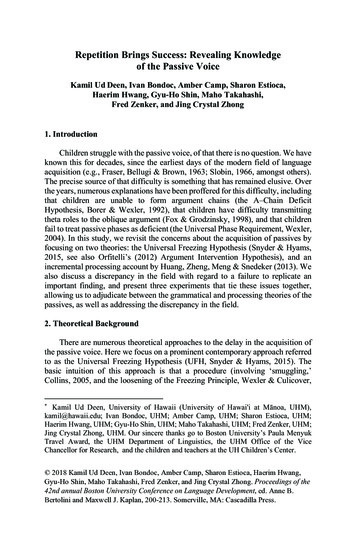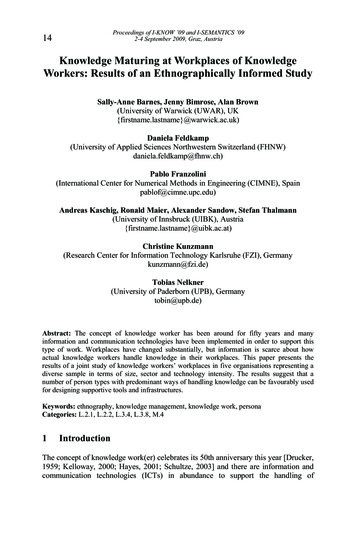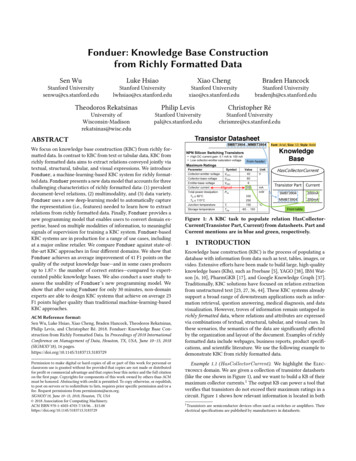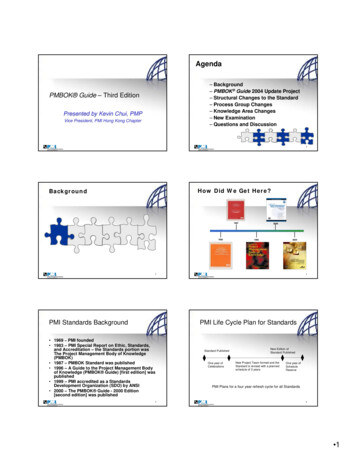
Transcription
Repetition Brings Success: Revealing Knowledgeof the Passive VoiceKamil Ud Deen, Ivan Bondoc, Amber Camp, Sharon Estioca,Haerim Hwang, Gyu-Ho Shin, Maho Takahashi,Fred Zenker, and Jing Crystal Zhong1. IntroductionChildren struggle with the passive voice, of that there is no question. We haveknown this for decades, since the earliest days of the modern field of languageacquisition (e.g., Fraser, Bellugi & Brown, 1963; Slobin, 1966, amongst others).The precise source of that difficulty is something that has remained elusive. Overthe years, numerous explanations have been proffered for this difficulty, includingthat children are unable to form argument chains (the A–Chain DeficitHypothesis, Borer & Wexler, 1992), that children have difficulty transmittingtheta roles to the oblique argument (Fox & Grodzinsky, 1998), and that childrenfail to treat passive phases as deficient (the Universal Phase Requirement, Wexler,2004). In this study, we revisit the concerns about the acquisition of passives byfocusing on two theories: the Universal Freezing Hypothesis (Snyder & Hyams,2015, see also Orfitelli’s (2012) Argument Intervention Hypothesis), and anincremental processing account by Huang, Zheng, Meng & Snedeker (2013). Wealso discuss a discrepancy in the field with regard to a failure to replicate animportant finding, and present three experiments that tie these issues together,allowing us to adjudicate between the grammatical and processing theories of thepassives, as well as addressing the discrepancy in the field.2. Theoretical BackgroundThere are numerous theoretical approaches to the delay in the acquisition ofthe passive voice. Here we focus on a prominent contemporary approach referredto as the Universal Freezing Hypothesis (UFH, Snyder & Hyams, 2015). Thebasic intuition of this approach is that a procedure (involving ‘smuggling,’Collins, 2005, and the loosening of the Freezing Principle, Wexler & Culicover,*Kamil Ud Deen, University of Hawaii ( ),kamil@hawaii.edu; Ivan Bondoc, UHM; Amber Camp, UHM; Sharon Estioca, UHM;Haerim Hwang, UHM; Gyu-Ho Shin, UHM; Maho Takahashi, UHM; Fred Zenker, UHM;Jing Crystal Zhong, UHM. Our sincere thanks go to Boston University’s Paula MenyukTravel Award, the UHM Department of Linguistics, the UHM Office of the ViceChancellor for Research, and the children and teachers at the UH Children’s Center. 2018 Kamil Ud Deen, Ivan Bondoc, Amber Camp, Sharon Estioca, Haerim Hwang,Gyu-Ho Shin, Maho Takahashi, Fred Zenker, and Jing Crystal Zhong. Proceedings of the42nd annual Boston University Conference on Language Development, ed. Anne B.Bertolini and Maxwell J. Kaplan, 200-213. Somerville, MA: Cascadilla Press.
2011980) is unavailable to children. Without this option, passive structures do notconverge. This procedure becomes available sometime in the fifth year of life, atwhich point the passive becomes available as well. Let’s see how this works withan example.For a sentence like (1), the structure of which is shown in (2), the externalargument John (or PRO in a short passive) occupies the specifier of vP while theinternal argument the book (the theme) is a complement to the verb. Movementof the internal argument to the [Spec, IP] position violates Relativized Minimality(RM, Rizzi, 1990), since it involves movement over the external argument—anominal that is featurally indistinct (in the relevant sense) from the internalargument.(1) The book was written by John.To get around this, a larger phrase (in which the internal argument occurs)such as PartP moves to a position above the external argument. This procedure isreferred to as ‘smuggling’ because it surreptitiously moves the internal argumentpast the external argument without violating RM. From this position, the externalargument moves into the [Spec, IP] position without any violation of RM, asshown in (3).This does, however, violate the Freezing Principle (Wexler & Culicover,1980), which states that movement from an already-moved constituent isprohibited. While exceptions of some sort are often invoked on most treatmentsof the passive, the loosening of the Freezing Principle here has the very desirableresult of providing an escape hatch for the RM problem outlined above. The UFHproposes that children are universally faithful to the Freezing Principle, and sosmuggling cannot act as an escape hatch for the passive in young children. Inchildren’s fifth year of life, the loosening of the Freezing Principle occurs (eitherthrough maturation or the development of processing abilities), and the passivecomes online. acquisition of the passive is captured by reference to the notion of semanticcoercion (the ability to construe a nonactional verb as a consequence of an event,Grillo, 2008). Nonactional verbs are thought to require semantic coercion(because of the lack of internal event structure), a process that is unavailable forchildren until after age six. So nonactional passives are even further delayedbecause of this second process. It is not until age six or seven that children arecapable of semantic coercion, thereby allowing an understanding of nonactionalpassives.
202(2)(3)
203However, there are several notable exceptions to the generalization thatpassives are acquired late by children. Crain, Thornton & Murasugi (2009) showthat young children are in fact able to produce passive questions, as in (4).(4) Which car gets crashen by the bus?The solution that Snyder & Hyams (2015) provide is that the context used toelicit such utterances topicalizes the internal argument, and as such, the internalargument is marked as [ topic], making it featurally different from the externalargument. This means movement of the internal argument into the [Spec, IP]position (without smuggling) does not violate RM, and so smuggling is not evenrequired in this case. A similar analysis is provided by Snyder & Hyams for datafrom Pinker, Lebeaux & Frost (1987).A different explanation for the difficulty in the passive is provided by Huanget al. (2013), who propose the Incremental Processing Hypothesis (IPH, see alsoHyams, Ntelitheos & Manorohanta, 2006, for a proposal in a similar vein). Thekey idea behind their approach is that children acquire canonical word order veryearly, and therefore they map the agent theta role onto the subject/first nominaland the theme theta role onto the object/second nominal. This canonical mappinginterferes with the online processing of passives, since when children hear the firstnominal of a passive, they incorrectly map the agent role to that nominal. As theyget evidence that the sentence they are hearing is a passive sentence (verbalmorphology, the by phrase), they are unable to reanalyze their incorrect mapping.As such, they either prevaricate and maintain their incorrect mapping (the socalled Kindergarten Path Effect, Trueswell, Sekerina, Hill & Logrip, 1999) or theylose track of their mapping altogether, resulting in confusion. In either case,children are likely to accept a mismatch test item under these conditions. Huanget al. test Chinese speaking children on passive sentences (and other sentencetypes), and find evidence for this incorrect initial mapping, as well as evidencefor prevarication.In the experiments presented below, we address these two approaches to thedelay in the acquisition of passives, with one experiment testing the idea thattopic marked passive sentences are easier to comprehend than non topic markedpassives, and another testing whether a novel manipulation might ease theprocessing difficulty of passive sentences presented by the canonical mappingeffect. In the next section, we review a wrinkle in the empirical evidence in thefield which our experiments ultimately also address.3. Replication of the Three Character EffectAs outlined above, research on children's acquisition of passives hasgenerally reported a failure of comprehension by children. O’Brien, Grolla and (2006) questioned this finding, suggesting that previous experimentstested children on passive sentences with contexts in which there were only twocharacters (one agent and one theme). This made the use of the by phrase
204infelicitous since a by phrase is used in the passive to disambiguate between twopotential agents. If there is only one potential agent in the scene, a short passiveis perfectly appropriate, and a by-phrase in that context is actually infelicitous.Such infelicity is enough to confuse children, thereby resulting in the acceptanceof mismatch test items (by the Yes-Bias, also known as the Principle of Charity,Crain & Thornton, 1998).O’Brien et al. (2006) hypothesized that providing contexts that properlymotivate the use of the by phrase would lead to higher comprehension by childrenin long passives. They tested 12 children aged 3;5–3;11 and 7 children aged 4;0–4;10 using a Truth Value Judgment Task (TVJT, Crain & Thornton, 1998) inwhich a third character (a second potential agent) was present (Experiment 1), anda protocol in which only one agent was present (Experiment 2). Results showedchildren’s improved comprehension on the three character experiment comparedto the two character experiment. This indicates that young children canunderstand passives if the use of the by phrase satisfies the felicity conditions fortheir use.More recently, an attempt to replicate this important finding has failed.Nguyen & Snyder (2017) tested 4 year old children using the same protocol asO’Brien et al. (2006) but were unable to replicate any effect of the third character.Nguyen & Snyder found that, whereas children performed better on actional thannonactional passives (a finding found in many studies over the years, e.g.,Maratsos, Fox, Becker & Chalkley 1985), there was no statistical differencebetween story types (i.e., 2 character vs. 3 character stories). In other words,adding a third character as a potential agent did not improve the 4 year olds’understanding of long passives. Failure to replicate is an important issue, and thisdiscrepancy requires further investigation. We attempt to do just that in ourexperiments, which we turn to now.4. Experiment 1We hypothesized that the difference between the findings of O’Brien et al.(2006) and Nguyen & Snyder (2017) was due to unnoticed methodologicaldifferences such as prosodic or discourse emphasis on certain characters or otherparts of the narration in the TVJT. In order to carefully control the delivery andpresentation of the stories, we presented the items using a pre recorded videoformat. This ensured control across all the child participants and the threeexperiments. This baseline experiment is a replication of O’Brien et al.’s study,but with careful control of presentational variables such as speed of presentationand prosodic differences between test items.4.1. ParticipantsAll participants attended a local preschool and were split into two groups:seven children aged 4;8–5;8 (mean age 5;1, the older age group) and nine childrenaged 3;10–4;6 (mean age 4;1, the younger age group). All children were living in
205an English speaking environment and had English as their only or dominantlanguage.4.2. MaterialsThe experiment began with three training items followed by eight test items(four passive items and four active items). We used two lists (randomly assignedto participants), each consisting of eight test items that were drawn from fourpassive actional verbs (push, pull, cover, chase) and four passive nonactionalverbs (surprise, anger, understand, remember) borrowed from Maratsos et al.(1985). Half of the test items were in the mismatch condition (target answer no)and half were in the match condition (target answer Yes). Each script (AppendixA) for the TVJT, modeled after O’Brien et al. (2006), included three animalcharacters, and was narrated and recorded in child friendly voices by nativeEnglish speakers. Photographs were taken of each scene in each story and thesewere laid into a movie timeline with the audio (using Adobe Premiere), creatinga child friendly cartoon like story (Figure 1).Figure 1. Screenshot from an item showing a story.4.3. ProcedureThe children were tested individually at their pre school. The pre recordedTVJT videos were presented to the child on a laptop computer with the audioplayed over headphones. Two experimenters were present: a primaryexperimenter, who interacted with the child, and a secondary experimenter, whorecorded answers but did not interact with the child. The session was also audiorecorded.Children were trained with three active items, followed by the critical itemsdescribed above. For each item, children were first introduced to three animalcharacters followed by the actual TVJT story (Appendix A). After the story, a
206puppet named Momo appeared on the screen along with all the characters and thepre recorded narrator asked her to say what had happened in the story. The puppetthen made a short statement about the story followed by the test sentence, asshown in (5).(5) Example of lead in and test sentences in Experiment 1Narrator: Hey Momo, can you tell us what happened in that story?Puppet: That was a fun story about Dog, Rabbit, and Frog. Let’s see In that story, Dog was understood by Rabbit. (Match)In that story, Rabbit was understood by Dog. (Mismatch)After the test sentence, the live experimenter paused the video and asked the childif the puppet was wrong or right. The child indicated their answer using a systemof stickers (a smiling face or a frowning face). When a frowning face was chosen,the experimenter asked the child to explain why the puppet had been wrong.4.4. ResultsFollowing standard practice, we report the nonactional mismatch items.Figure 2 shows the results from Experiment 1. The older children performed wellwith the nonactional mismatch items, correctly rejecting them more than 90% ofthe time, as expected. The younger children, however, showed relatively poorperformance on the nonactional mismatch items, rejecting the items at just aboutchance rate (55%).Experiment 1: Rejection of Mismatch Nonactional Items100%80%60%40%20%0%Older Children (5;1)Younger Children (4;1)Figure 2. Rates at which older and younger children rejected mismatch testsentences in trials with nonactional verbs during Experiment 1.
2074.5. Discussion – Experiment 1The results from Experiment 1 show that the 3 character story did not appearto help young children comprehend passive sentences correctly. Despite tempo,prosody, and many other extra syntactic factors being controlled, children in theyounger age group comprehended long nonactional passives at chance level,suggesting that they are unable to understand passive sentences. Thus, we wereunable to replicate O’Brien et al.’s (2006) findings. Instead, our results echoedthose of Nguyen & Snyder (2017).5. Experiment 2We tested whether topicalizing the theme would improve comprehension ofpassive sentences, as hypothesized by Snyder & Hyams (2015). Recall thataccording to Relativized Minimality, if the theme is marked as [ topic], it shouldbe able to move past the external argument without causing an RM violation. Wemanipulated the topicality of the theme by changing the wording of the narrator’slead in to the test sentence so as to make the theme in the test sentence moretopical.5.1. ParticipantsParticipants were children from the same preschool as in Experiment 1. Ninechildren aged 3;9–4;3 (mean age 3;11.17) were tested in this second experiment.Note that these participants were all regarded as “younger” children given theirrange of ages, which was similar to that of the younger group in Experiment 1.5.2. MaterialsAll materials were identical to those used in Experiment 1 except for the lead in.In Experiment 1, the narrator used a generic lead in, saying “Hey Momo, can youtell us what happened in that story?”, which was immediately followed by thepuppet’s response, as shown in (5). In Experiment 2, however, the lead in waschanged to topicalize one of the characters (the one who would be the theme ofthe test sentence), following the template presented in (6). Note that the sentence‘And something interesting happened with A’ was included to specifically drawattention to character A, thereby topicalizing it.(6) Example of the modified lead in in Experiment 2Narrator: Hey Momo, that was a fun story about A, B and C.They made such a mess with those crumbs, didn’t they? (or similar).And something interesting happened with A. Could you tell us whathappened?Puppet: That WAS a fun story. Let’s see In that story, A was verbed by B.
2085.3. ProcedureThe procedure was identical to Experiment 1, including the video TVJT andin person experimenters.5.4. ResultsChildren in Experiment 2 rejected mismatch nonactional passives 89% of thetime (compared to chance level in Experiment 1), showing that topicalizing theobject significantly improves comprehension of passives.5.5. Discussion – Experiment 2Given that the only change between Experiments 1 and 2 was the change inthe lead in sentence to make the theme topicalized, the results are consistent withthe UFH: Adding the [ topic] feature to the theme resulted in highercomprehension rates, exactly as predicted by the UFH. These results are, however,also consistent with the IPH: Because topics track subjecthood, when the themehas been topicalized, the child might predict that this topicalized nominal will bethe subject of the following (test) sentence. Thus, the expectation that the firstargument will be an agent may have been reduced by the topicalizing of the theme.In the next experiment, we attempt to tease these two theories apart using a novelbut simple manipulation: repeating the test sentence.6. Experiment 3Experiment 3 was identical to Experiment 1 except that the test sentence wasdelivered twice. Any parent will tell you that repeating things to children helpswith comprehension, but it was unclear if this technique would also help withpassives, a construction children typically have difficulty comprehending.If the UFH is on the right track, then a repeated test sentence should have noimpact on whether they violate the Freezing Principle or not. There should be noeffect of repeating the test sentence, since the Freezing Principle should hold untilmaturation at around age 4 years, and before that age children should not be ableto smuggle DP objects above subjects.However, following the IPH, repeating the test sentence may have abeneficial effect. We hypothesized that if the difficulty with passives is one ofexpectations regarding thematic roles, then a repeated test sentence should allowchildren to overcome these expectations. On the first presentation of the testsentence, children assign the first nominal the agent role, which is the preferredpattern in English. They then encounter passive morphology and a by phrase butare unable to reanalyze online (as outlined above). However, when they hear therepetition of the test sentence—their second bite at the apple, so to speak—theyknow that assigning the agent role to the first nominal is a losing proposition, andso they either delay thematic role assignment, or they assign a different thematic
209role to that first nominal. Thus, on this view a repeated test sentence may influencechildren’s comprehension of passives.6.1. ParticipantsParticipants included children from the same preschool as in Experiments 1and 2, as well as additional children recruited from the wider community. Ninechildren were included in Experiment 3, aged 3;8–4;6 (mean age 4;0). As withExperiment 2, these children were deemed to be equivalent to the younger agedchildren in Experiments 1 and 2.6.2. MaterialsAll materials were identical to Experiment 1 except that the test sentence wasrepeated (with a 1000 ms pause between the two iterations). The second iterationof the test sentence was identical to the first. Note that the baseline lead in fromExperiment 1 was used in Experiment 3, not the topicalized version fromExperiment 2.6.3. ProcedureThe procedure was identical to Experiment 1 aside from the modifiedpresentation of the test sentences.6.4. ResultsIn Experiment 3, when the test sentence is repeated, young children correctlyrejected mismatch nonactional passive sentences at a rate of 83.3%, compared to55% in the baseline condition. This suggests that a repetition of the test sentenceimproves comprehension of passives.6.5. Discussion – Experiment 3Figure 3 summarizes the results of the three experiments. In the baselinecondition, children rejected the mismatch nonactional passives at about chance.However, when the theme was topicalized, we see an increase in correct rejectionrates to 88%. Likewise, in a non topicalized setting, when the test sentence isrepeated, the rejection rate is 83%. We interpret the improved accuracy with arepeated test sentence to show that children’s difficulty with passives is not adeficit in competence. A grammatical account of failure on the passive does notpredict any improvement in comprehension of the passive. If smuggling is notpermitted, it just is not permitted, no matter how many times a test sentence isrepeated. On the other hand, the IPH accounts for this nicely. We hypothesizedthat if the difficulty with passives is one of expectations, then a repeated testsentence should allow children to overcome these expectations. This hypothesiswas borne out by our experiments.
210Rejection of Mismatch Nonactional Items100%80%60%40%20%0%Experiment 1 BaselineExperiment 2 TopicalizationExperiment 3 Repeated NominalsFigure 3. Rates at which young children rejected mismatch test sentences intrials with nonactional verbs in Experiments 1, 2, and 3.7. Overall Discussion and ConclusionTheories for the delay in the acquisition of the passive abound in theliterature. Here we tested two such theories: one a grammatical theory for thedelay in the passive (the Universal Freezing Hypothesis, Snyder & Hyams, 2015)and the second the Incremental Processing Hypothesis (Huang et al., 2013).Moreover, we also attempted to replicate O’Brien et al.’s (2006) TVJT finding inwhich adding a third (potential agent) character to the context increasescomprehension accuracy of passives by young children. In the end, we believeour contributions to the understanding of the acquisition of the passive arethree-fold.First, we hypothesized that the failure of Nguyen & Snyder (2017) toreplicate O’Brien et al. (2006) was due to micro variations in the presentationmaterials between the two research groups. For example, it may have been thecase that in some items the theme was more prosodically emphasized(unintentionally). It is also possible that the speed at which the test sentences weredelivered varied from item to item (also unintentionally). We controlled thesefactors by using pre recorded stimuli, both audio and visual. We carefullymanipulated stress, prosody, tempo, etc. and presented the exact same stimuli toall children. Nonetheless, we failed to replicate O’Brien et al.’s findings.Our second contribution comes from the effect of topicality on thecomprehension of passive sentences. Experiment 2 purposefully manipulated thetopicality of the theme by drawing attention to it in the lead-in while keepingeverything else identical to the previous experiment. We found that topicalizingthe theme did in fact significantly increase the comprehension rates of passivesentences by young children.
211Finally, and perhaps most interestingly, we found that a simple repetition ofthe test sentence resulted in increased comprehension rates of passive sentencesby young children. This result suggests that the underlying difficulty that childrenface with the passive is not grammatical in nature, but more likely a result ofprocessing challenges that children face with passive sentences. We endorse anincremental processing approach to the delay in passives (Huang et al., 2013,although see Bever, 1970, amongst many others), though other interpretations arequite possible.Regardless, we find the results from our last experiment incompatible withgrammatical theories of the delay in the passive, and instead conclude thatchildren have full knowledge of the passive structure and are able to perform allthe operations associated with it (e.g., Demuth et. al., 2010; Messenger et al.,2011; Bencini & Valian, 2008, amongst others). There is no deficit in competence,and we conclude that children’s grammars are maximally continuous with adultgrammars, though the parsing and processing mechanisms that deploy thatknowledge may be immature and still developing.Appendix A: Example of a Story with a Nonactional Verb (surprise) in theMismatch ConditionMonkey doesn’t like surprises, but his friends find it really fun to surprise himanyway. One day, Pig decides to play a prank on Monkey. He decides to hidebehind Monkey so he can surprise him. But he was seen by Monkey and failed.After a little while, Elephant decides to try to surprise Monkey. Elephant slowlycreeps up behind Monkey and grabs him on the shoulder. Elephant succeeded insurprising Monkey. In revenge, Monkey tried to surprise Elephant, but he failed.Experiment 1Narrator:Puppet:Experiment 2Narrator:Puppet:Experiment 3Narrator:Puppet:Hey Momo, can you tell us something about the story?Hmm, that was a fun story about Elephant, Monkey and Pig.Let’s see in that story Elephant was surprised by Monkey.Hey Momo, that was a fun story about Elephant, Monkey, andPig. They took turns trying to surprise each other, andsomething interesting happened with Elephant. Could you tellus what happened?Hmm, that WAS a fun story. Let’s see in thatstory Elephant was surprised by Monkey.Hey Momo, can you tell us something about the story?Hmm, that was a fun story about Elephant, Monkey and Pig.Let’s see in that story Elephant was surprised by Monkey(1000ms pause) Elephant was surprised by Monkey.
212ReferencesBencini, Giulia & Virginia Valian (2008). Abstract sentence representation in 3-year-olds:Evidence from comprehension and production. Journal of Memory and Language, 59,(1), 97–113.Bever, Thomas G. (1970). The cognitive basis for linguistic structures. In John R. Hayes(Ed.), Cognition and the development of language (pp. 279–362). New York: Wiley.Borer, Hagit & Kenneth Wexler. (1987). The maturation of syntax. In Thomas Roeper &Alexander E. Williams (Eds.), Parameter Setting (pp. 23–172). Dordrecht: Reidel.Collins, Chris. (2005). A smuggling approach to the passive in English. Syntax, 8(2), 81–120.Crain, Stephen & Rosalind Thornton. (1998). Investigations in Universal Grammar: Aguide to experiments on the acquisition of syntax and semantics. Cambridge, MA:MIT Press.Crain, Stephen, Rosalind Thornton, & Keiko Murasugi. (2009). Capturing the evasivepassive. Language Acquisition, 16(2), 123–133.Demuth, Katherine, Francina Moloi, & Malillo Machobane. (2010). 3 Year olds’comprehension, production, and generalization of Sesotho passives. Cognition,115(2), 238–51.Fox, Danny & Yosef Grodzinsky. (1998). Children’s passive: A view from the by phrase.Linguistic Inquiry, 29(2), 311–332.Fraser, Colin, Ursula Bellugi, & Roger Brown. (1963). Control of grammar in imitation,comprehension, and production. Journal of Verbal Learning and Verbal Behavior,2(2), 121–135.Grillo, Antonino. (2008). Generalized minimality: Syntactic underspecification in Broca’saphasia. Utrecht: LOT Publications.Huang, Yi Ting, Xiaobei Zheng, Xiangzhi Meng, & Jesse Snedeker. (2013). Children’sassignment of grammatical roles in the online processing of Mandarin passivesentences. Journal of Memory and Language, 69(4), 589–606.Hyams, Nina, Dimitris Ntelitheos, & Cecile Manorohanta. (2006). Acquisition of theMalagasy voicing system: Implications for the adult grammar. Natural Language andLinguistic Theory, 24(4), 1049–1092.Maratsos, Michael, Dana E. C. Fox, Judith A. Becker, & Mary Anne Chalkley. (1985).Semantic restrictions on children’s passives. Cognition, 19(2), 167–191.Messenger, Katherine, Holly P. Branigan, & Janet F. McLean. (2011). Evidence for(shared) abstract structure underlying children’s short and full passives. Cognition,121(2), 268–274.Nguyen, Emma & William Snyder. (2017). The (non) effects of pragmatics on children’spassives. In Maria LaMendola & Jennifer Scott (Eds.), Proceedings of the 41st AnnualBoston University Conference on Language Development (pp. 522–531). Somerville,MA: Cascadilla Press.O’Brien, Karen, Elaine Grolla, & Diane Lillo Martin. (2006). Long passives areunderstood by young children. In David Bamman, Tatiana Magnitskaia, & ColleenZaller (Eds.), Proceedings of the 30th annual Boston University Conference onLanguage Development (pp. 441–451). Somerville, MA: Cascadilla Press.Orfitelli, Robyn Marie. (2012). Argument intervention in the acquisition of A movement(Doctoral dissertation). UCLA.Pinker, Steven, David S. Lebeaux, & Loren Ann Frost. (1987). Productivity and constraintsin the acquisition of the passive. Cognition, 26(3): 195–267.
213Rizzi, Luigi. (1990). Relativized minimality. Cambridge, MA: MIT Press.Slobin, Dan I. (1966). Grammatical transformations and sentence comprehension inchildhood and adulthood. Journal of Verbal Learning and Verbal Behavior, 5(3),219–227.Snyder, William & Nina Hyams. (2015). Minimality effects in children’s passives. In ElisaDi Domenico, Cornelia Hamann, & Simona Matteini (Eds.), Structures, strategiesand beyond: Essays in honour of Adriana Belletti (pp. 343–368). Philadelphia: JohnBenjamins.Trueswell, John C., Irina Sekerina, Nicole M. Hill, & Marian L. Logrip. (1999). Thekindergarten path effect: Studying on line sentence processing in young children.Cognition, 73(2): 89–134.Wexler, Kenneth. (2004). Theory of phasal development: Perfection in child grammar. InAniko Csirmaz, Andrea Gualmini & Andrew Nevins (Eds.), Plato’s problem:Problems in language acquisition, (pp. 159–209). Cambridge, MA: MIT
Repetition Brings Success: Revealing Knowledge of the Passive Voice Kamil Ud Deen, Ivan Bondoc, Amber Camp, Sharon Estioca, Haerim Hwang, Gyu-Ho Shin, Maho Takahashi, Fred Zenker, and Jing Crystal Zhong 1. Introduction Children struggle with the passive











